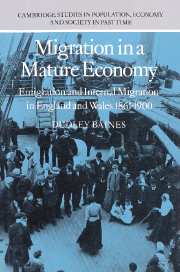Book contents
- Frontmatter
- Contents
- List of tables
- List of figures
- Acknowledgements
- 1 Introduction: the scope of the study
- 2 Issues in the history of European emigration, 1840–1914
- 3 The characteristics of British emigrants before 1914
- 4 The estimation of migration by county of birth
- 5 Return migration to Britain, 1860–1914
- 6 The birthplace of English and Welsh emigrants, 1861–1900
- 7 English and Welsh emigrants in the 1880s and 1890s
- 8 Emigration and urban growth
- 9 Rural-urban stage emigration, 1861–1900
- 10 Wales and the Atlantic economy, 1861–1914
- A summary of conclusions
- Appendices
- Bibliography
- Index
2 - Issues in the history of European emigration, 1840–1914
Published online by Cambridge University Press: 24 November 2009
- Frontmatter
- Contents
- List of tables
- List of figures
- Acknowledgements
- 1 Introduction: the scope of the study
- 2 Issues in the history of European emigration, 1840–1914
- 3 The characteristics of British emigrants before 1914
- 4 The estimation of migration by county of birth
- 5 Return migration to Britain, 1860–1914
- 6 The birthplace of English and Welsh emigrants, 1861–1900
- 7 English and Welsh emigrants in the 1880s and 1890s
- 8 Emigration and urban growth
- 9 Rural-urban stage emigration, 1861–1900
- 10 Wales and the Atlantic economy, 1861–1914
- A summary of conclusions
- Appendices
- Bibliography
- Index
Summary
We pointed out in the introductory chapter that there has been not only a great increase in research on European emigration in the last two decades, but that the research has tended to move in relatively new directions. There has been an increase in the use of quantitative data, much of which had been little exploited before, and a shift in emphasis towards research on the causes of emigration – in other words towards the social and economic changes in the countries and regions of emigration. A paper read by Frank Thistlethwaite in Stockholm in 1960, was almost certainly an important turning point. Thistlethwaite's paper encouraged historians to turn away from the conditions of settlement and assimilation in overseas countries, with which many had been concerned, and to look at the factors in the sending countries which affected the decision to emigrate. The key issue, of course, was why only some individuals decided to emigrate, and not others. This may have been because conditions in one area were more conducive to emigration than in another area, or it could be that some people were more likely to consider emigration than others, even if, for the sake of argument, the benefits of emigration would be the same for all. Historians had been interested in these issues before, of course. For example, Marcus Hansen published, in 1940, the first volume of a study which laid great emphasis on the European background of emigrants.
- Type
- Chapter
- Information
- Migration in a Mature EconomyEmigration and Internal Migration in England and Wales 1861–1900, pp. 8 - 44Publisher: Cambridge University PressPrint publication year: 1986

